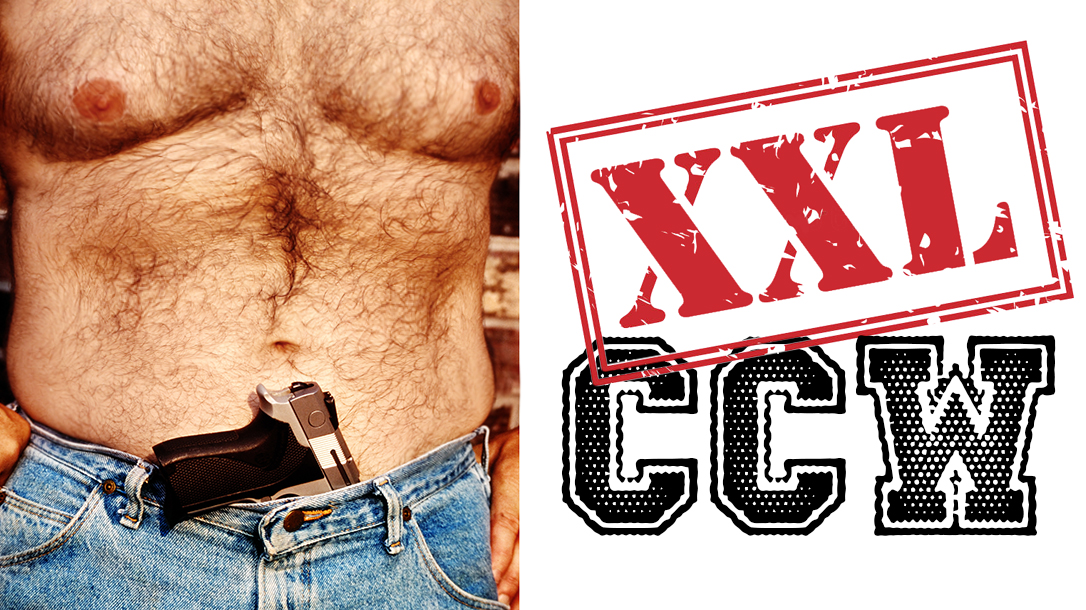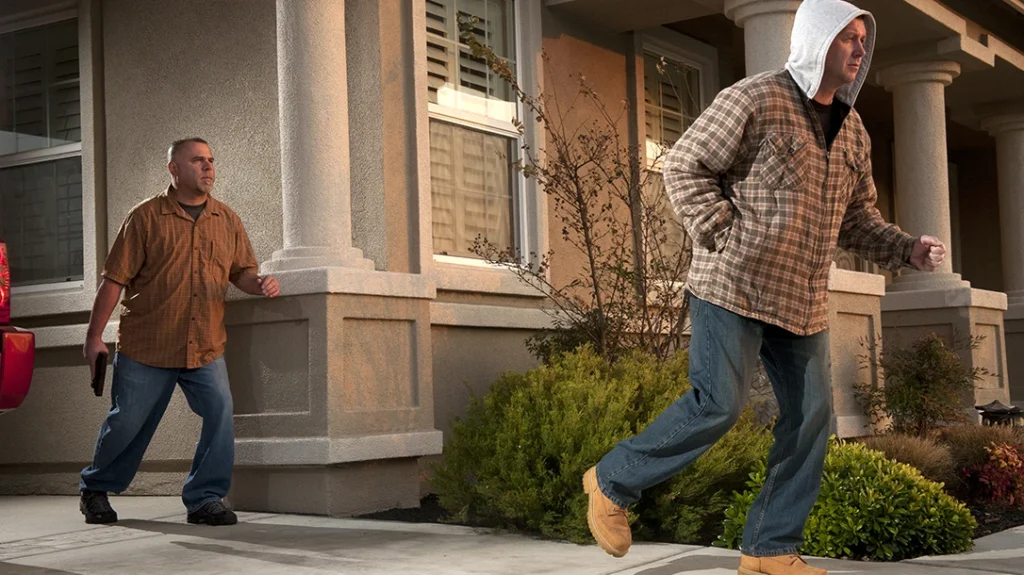When most people think of appendix carry, they think of some high-speed operator with six-pack abs and a sub-second draw time. I’m here to tell my fellow fluffy guys that you can get that sexy, sub-second draw time and carry in the appendix position without doing 10-minute abs and eating plain tuna for the next five years. It is totally possible to make this method of carry comfortable for the bigger dudes; however, it does take some trial and error, so be patient. Just keep in mind that everyone’s body is different, and what works for one person might not work for another. I have changed my firearm and holster setup several times to find a system that works for me, and hopefully, this information will streamline that process for you.
Concealed Carry For Everyone!
Just a little disclaimer: This information is not limited solely to the bigger fellas. Everything I touch upon in this article will hopefully make concealed carry more manageable for shooters of all shapes and sizes.
First and foremost, Kydex is king. Kydex is a plastic material, that when heated becomes malleable, so that you can form fit it to your specific firearm. Let’s go over the keys to a proper Kydex holster. A proper holster must cover the entire trigger guard, it must be specific to your make and model of handgun, and it should come from a reputable company making a quality product. There are two options when it comes to Kydex AIWB holsters: the standard holster that you can also carry at the 3-4 o’clock position and the “appendix rig.” The appendix rig is a holster that also features a spare magazine carrier molded into the design for a one-piece package. I will go over the pros and cons of each in a bit.
Advertisement — Continue Reading Below
Some other features to look for in a holster are a wing/claw to mitigate grip printing and the overall holster length for proper pelvic contact. What I mean by pelvic contact is the amount or length of holster that contacts your abdomen and pelvis. For firearms that are the size of a Glock 19 and up, you shouldn’t have to worry, but anything with a short barrel/slide, like an M&P Shield, ends up having more gun sticking out of your pants than in them.

Size Matters
When this occurs, the gun will want to tip forward and point inward. To remedy this, talk to the holster manufacturer and see if they offer a longer option to increase the length of the Kydex, which will compensate for a shorter barrel. For instance, some Glocks and M&Ps are dimensionally similar to other models, with the slide and barrel being the only size difference. For example, the Glock 19 and the Glock 17 in some cases can share the same holster.
Advertisement — Continue Reading Below
The wing or claw, as some companies call it, is a metal or polymer attachment that is typically located adjacent to the trigger guard of your handgun. This little piece is the key to tucking the grip of your handgun up against your body and is the key component to minimizing printing. Notice I said “minimizing.” You are going to print, so get over it. The average person is not looking directly at your stomach and searching for a firearm, and this method is far better than having your shirt tail dangling over the grip of your handgun—like I see constantly with guys who carry in the small of the back or in the 4 o’clock position. With a proper holster and suitable clothing, printing should not be an issue, which moves us into wardrobe.
Flannel or Tye-Dye?
I’m going to keep the clothing portion pretty simple. I’m a simple guy; I wear button-down flannels in the colder months and button-down, short-sleeve shirts in the warmer months, both of which are a little loose and drape down past my belt line. Patterns like flannel and floral also help to break up any concealed carry printing that may inevitably occur. Before you freak out about no longer flexing in your favorite Grunt Style T-shirt, yes, you can conceal a firearm in a T-shirt. Just make sure you are buying something with a little extra room around the midsection and that preferably covers the entirety of your stomach. You don’t want to look like Phil Collins from Trailer Park Boys with your G19 hanging out.
If you have issues with your firearm chafing your belly, try wearing an undershirt, but tuck the undershirt inside your underwear. Just do it, and stop making it weirder than it has to be. Honest to God, this will help keep everything tidy, and I guarantee you will spend less time tucking your shirt back in throughout the day. Compression-fit materials work really well, but this concept can still be applied to regular cotton undershirts. When it comes to pants, buy two inches larger than your normal waist size and try to stay away from nut huggers.
Advertisement — Continue Reading Below
Major Belly Flops
I care more about how my jeans fit around my crotch than I do the size of the waistband when it comes to concealed carry. Pants that are tight in the crotch will force the muzzle inward and the grip outward. What you end up with is feeling like the grip of your gun is always spilling forward and the muzzle is constantly digging into your sack.
Last but not least is your belt. Please do not skip out on a good carry belt. It does not have to be expensive, but it should be designed for firearms use. My belt is the Blue Alpha Gear EDC belt, which is a webbing-style belt with a solid core. Last time I checked, it was around $30, making it less than a leather belt at a typical department store. However, it provides the rigidity necessary to hold up a firearm.
Bell Bottoms Or Skinny Jeans?
Rigidity is what makes gun belts gun belts! This is the up-and-down, or lateral rigidity, that you get from a belt with a solid core. To visualize the difference, pick up a regular leather belt long-ways and fold it inward like a hotdog bun; that should not be possible with a carry belt. That rigidity is what also helps to keep the gun oriented upright as opposed to tipping forward.
Advertisement — Continue Reading Below
Let’s back up just a touch and talk about standard holsters versus appendix rigs. I don’t mind the appendix rig, but I personally have found myself carrying a standard holster in the appendix position and carrying my spare mag in a NeoMag holster. This type of magazine carrier is basically a magnet clipped inside your pocket that your magazine sticks to and stays oriented properly while it rides around in your pocket. The pro to carrying the rig is that you have everything in one setup, ready to go. If you are like me and already have a bunch of stuff in your pockets, this can be really helpful in cutting down on the clutter.
One downside of this setup for me is that I typically have to position my appendix rig a little higher to accommodate for my muzzle being midline and contacting my hog. Yes, it is pointed at your dong. In order to adjust the holster so that it rides higher, you just unscrew and move the belt clips on the holster to your desired position so that the unit rides a little higher and clears your “parts.” You are just going to have to decide if you have the mental fortitude to carry this way or not.
Start Carrying!
That being said, the pro to the standard holster is that you have more flexibility in its positioning so that it is not directly over your member. I nestle the muzzle of my firearm in that void where the pelvis meets the leg. There’s a little valley or void in your leg crease that is just perfect for indexing your firearm. Even a CZ P-10 C with an Inforce APLc light attached is able to sit in this space without any uncomfortable rubbing or chafing. This will position your muzzle next to your junk instead of on top of it. Plus, running the gun lower means that it is easier to go “gun over gut.”
Advertisement — Continue Reading Below























